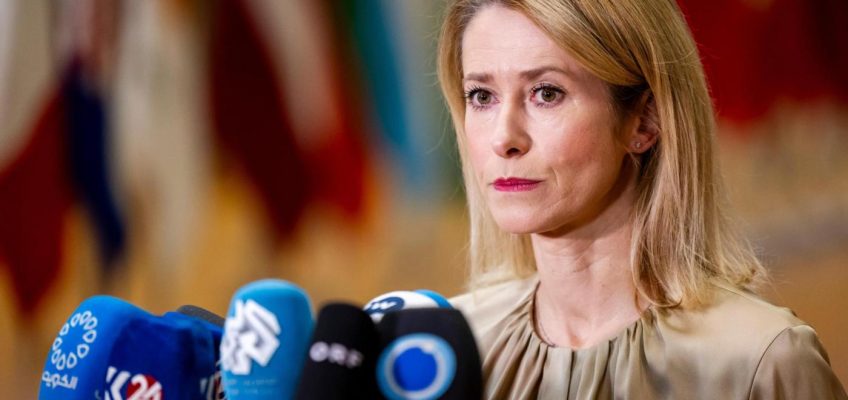By STEPHANIE LIECHTENSTEIN
VIENNA (AP) — The U.N. atomic watchdog on Thursday demanded that Iran fully cooperate with the agency and provide “precise information” about its stockpile of near weapons-grade uranium, as well as grant its inspectors access to Iranian nuclear sites.
Related Articles
US and Russia draw up peace plan for Ukraine that includes big concessions from Kyiv
Fire prompts evacuations at UN climate talks in Brazil, but officials say no one hurt
Israel announces plan to seize historical site in the West Bank as a new settlement appears
Today in History: November 20, Nuremberg trials begin
UN urges all nations to observe a truce during the Winter Olympics in Italy
The development sets the stage for a likely further escalation between the U.N. nuclear agency and Iran, which has reacted strongly to similar moves by the watchdog in the past.
Nineteen countries on the International Atomic Energy Agency’s 35-member board of governors voted for the resolution at the IAEA’s headquarters in Vienna, according to diplomats who spoke on condition of anonymity to describe the outcome of the closed-doors vote.
Russia, China and Niger opposed it, while 12 countries abstained and one did not vote.
The resolution — put forward by France, the United Kingdom, Germany and the United States — says Iran must provide the IAEA with the latest information on its nuclear stockpile, “without delay.” A draft was seen by The Associated Press.
After the strikes in June
Since Israel and the United States struck Iran’s nuclear sites during the 12-day war in June, Iran has not given IAEA inspectors access to nuclear sites that were affected by the strikes — even though Tehran is legally obliged to cooperate with the watchdog under the Nuclear Nonproliferation Treaty.
The agency also has been unable to verify the status of the stockpile of near weapons-grade uranium since the June bombing, according to a confidential IAEA report seen by the AP last week.
According to the IAEA, Iran maintains a stockpile of 972 pounds of uranium enriched up to 60% purity — a short, technical step away from weapons-grade levels of 90%.
That stockpile could allow Iran to build as many as 10 nuclear bombs, should it decide to weaponize its program, IAEA director general Rafael Grossi warned in a recent interview with the AP. He added that it doesn’t mean that Iran has such a weapon.
Such highly enriched nuclear material should normally be verified every month, according to the IAEA’s guidelines.
Iran slams the decision
Talking to reporters outside the IAEA boardroom, Iran’s Ambassador to the IAEA Reza Najafi denounced Thursday’s resolution and said that it was designed to “exert undue pressure on Iran” and propagate a “false and misleading narrative of the present situation.”
FILE -A national flag of Iran waves in front of the building of the International Atomic Energy Agency, IAEA, in Vienna, Austria, Dec. 17, 2021. (AP Photo/Michael Gruber, File)
He described the authors of the resolution as “deaf and visionless” and said that they maintain “an arrogant and self-assured posture” by presuming that Iran is “obliged to continue its routine cooperation with the agency even under bombardment.”
Najafi said that Iran considers the current situation “far from normal,” given that safeguarded facilities in Iran that contain “dangerous nuclear material” have been attacked.
Najafi said that Iran is “fully prepared for meaningful and constructive engagement” but at present, “the authors of resolutions have chosen a different course, under the mistaken belief that the pressure and threat will yield results.”
Responding to questions from journalist, Najafi said Iran will announce its response at a later stage.
Cutting ties
Iran suspended all cooperation with the IAEA after the war with Israel. Grossi then reached an agreement with Iranian Foreign Minister Abbas Araghchi in Cairo in early September to resume inspections.
But later that month, the U.N. reimposed crushing sanctions on Iran via the so-called snapback mechanism contained in the 2015 Iran nuclear deal, drawing an angry response from Tehran and leading it to halt implementation of the Cairo agreement.
The snapback mechanism reactivated six U.N. Security Council resolutions that address Iran’s nuclear and ballistic missile program, reinstate economic sanctions against Iran and contain other restrictions, such as halting all uranium enrichment.
Thursday’s resolution instructed Grossi to report on the implementation of the reinstated restrictions. It also requested that he ensure his reporting “includes information on the verification of Iran’s uranium stockpile, including the locations, quantities, chemical forms, and enrichment levels, and the inventories of centrifuges and related equipment.”
Iran has long insisted its program is peaceful, but the IAEA and Western nations say Tehran had an organized nuclear weapons program up until 2003.
Thursday’s resolution demanded that Iran “acts strictly in accordance” with the so-called Additional Protocol that it signed in 2003 but never ratified.
That protocol grants more powers and oversight to the IAEA, especially when it comes to conducting snap inspections at undeclared nuclear sites.
Iran suspended its implementation of the Additional Protocol in 2021 in response to the United States’ withdrawal from the 2015 nuclear deal that lifted economic sanctions in exchange for restrictions on Iran’s nuclear program.
The Associated Press receives support for nuclear security coverage from the Carnegie Corporation of New York and Outrider Foundation. The AP is solely responsible for all content. ___ Additional AP coverage of the nuclear landscape: https://apnews.com/projects/the-new-nuclear-landscape/




